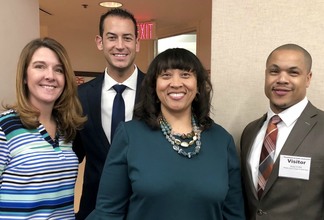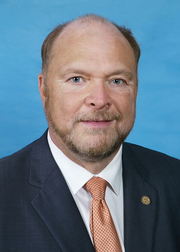 Board Adopts Supplemental Budget Recommendations
Asking to Reverse $5.1 Million Cut to DPI Budget
Members of the
State Board of Education voted at their March meeting to request $156 million in additional
state spending for schools in 2018-19 with stronger technology support, more
school nurses, counselors, psychologists and social workers and increased
funding for textbooks, digital learning resources and other instructional resources
and classroom supplies.
The request was
made in response to the Office of State Budget and Management for its
development of Gov. Roy Cooper’s supplemental budget recommendations to the
General Assembly to consider during its short session this year. The board’s
requests represent a 1.7 percent increase of the state’s General Fund budget
for the current year. The Office of State Budge and Management asked state
agencies to limit their expansion requests to no more than a 2 percent increase
in spending.
The largest
single item on the board’s list of expansion items would be an investment in
school building technology support for digital learning, at a cost of $56
million. The funds would allow school districts to provide one technology
support position for every three schools. The board is also asking for $18.7
million to hire additional instructional support staff, such as counselors,
psychologists and social workers, to make gains on its five-year goal to
achieve a ratio of one support position for every 200 students. The current
ratio is one to 219 such positions. To reduce the ratio of school nurses to
students to one to 750, the board is requesting $12.8 million to hire
additional nurses.
As part of its
$156 total expansion request, the board is also asking for $8.3 million, of
which $2.9 million would be non-recurring, for the Department of Public
Instruction to better support schools with teacher professional development
focusing on personalized learning, cybersecurity training for public school
staff and improved school business support for local districts.
In addition, as
part of its letter accompanying its expansion requests, the board is asking the
state to roll back $5.1 in additional reductions to DPI’s budget for 2018-19
included in the two-year budget adopted by the legislature last year.
“To function at
a high level, the system of schools also requires significant support and
technical assistance from the state education agency, NCDPI,” states the
letter, signed by Bill Cobey, board chairman. “The agency has been reduced by
approximately $25 million and 250 full-time equivalents over the past 10 years
while the system of schools has grown in size and complexity; as a result
critical serves to districts and schools are beginning to suffer.”
In its letter,
the board also urges the governor to continue efforts to increase pay for
teachers and other school employees.
“A system of
excellent public schools requires a well-trained, committed cadre of staff,”
the letter states, “and recruiting and retaining the best staff requires
competitive salaries.”
|
 Board Reviews Annual Report on Crime,
Suspensions, Dropouts
North Carolina public schools reported fewer overall incidences of crime
and violence during the 2016-17 school year from the previous year, continuing
a long-term decline in numbers of offenses, according to the N.C. Department of
Public Instruction’s 2016-17 Consolidated Data Report approved by the State Board of Education this month.
The report also shows a decline in numbers of both short- and long-term
suspensions and expulsions. The numbers of students dropping out of high school
grades was up slightly, resulting in a marginal increase in the state’s dropout
rate, from 2.29 percent in 2015-16 to 2.31 percent in 2016-17.
Overall, the total number of reportable crimes across all grades
decreased by 1.9 percent in 2016-17 from the previous year, with the rate per
1,000 students declining by 2.1 percent, from 6.62 percent to 6.48 percent In
all, 9,834 offenses were reported last year, down from 10,020 in 2015-16 and
from 10,630 in 2012-13.
Among high school students, who account for more than half of all reportable
offenses, the number of reportable crimes declined by 4 percent and the rate
per 1,000 students improved to 12.12 from 12.75, a decrease of 4.9 percent.
Schools are
required to report 16 offenses that occur on campus or school property, of which
nine are considered dangerous and violent. In 2016-17, those nine categories
represented 278 individual instances, or 2.8 percent of all 9,834 reported
offenses.
Among the most
frequently reported offenses, illegal possession of a controlled substance declined
last year to 4,289 from 4,639 the year before; possession of a weapon other
than a firearm remained virtually unchanged at 2,745, and assault on school
personnel increased to 1,431 from 1,329. Possession of alcoholic beverages
declined to 882 from 934 in the previous year.
|
 Board Approves
Accountability Measure Revision to Meet ESSA Requirement
To satisfy
federal reporting requirements under the Every Student Succeeds Act, the board
adjusted the calculation used to measure the percentage of students meeting
benchmarks under the ACT WorkKeys assessment, taken by Career and Technical
Education concentrators in the 12th grade.
Previously, the
number of students who achieved a Silver certificate or higher on the WorkKeys
assessment was divided by the total number of only those students who took it
to calculate the percentage reported in accountability reports. However, the
U.S. Department of Education said that under ESSA rules, the percentage of
students passing the exam must be measured instead using all students in the
cohort – in other words, all students in the 12th grade – for
calculating the percentage of students meeting the benchmark standard of Silver
on the WorkKeys assessment.
Because the
change will now result in low percentages of students meeting the WorkKeys
benchmarks, DPI will seek a change in state accountability rules that would
combine ACT results – held over or banked from 11th grade – with
WorkKeys results to measure the percentage of students meeting benchmark
performance on either of the two assessments. Under current rules for
determining School Performance Grades, student performance on the ACT and
WorkKeys assessment are considered as separate factors.
|

Legislative Reports on
Teacher Bonuses Show Statewide Reach, Benefits
Nearly 14,000
teachers of elementary- and middle-grade students were eligible for bonus pay this
year based on the growth their students made in reading or math during the
2016-17 school year, according to reports the board approved last week prior to
being submitted to the legislature.
During the last
two years, the legislature has created bonus programs to reward teachers whose
students make strong progress as measured by Education Value-Added Assessment
System (EVAAS).
Under the
third-grade Read to Achieve teacher bonus program, now in its second year, about
1,380 third-grade reading teachers were eligible to receive $3,623 if they were
in the top 25 percent of teachers statewide based on their EVAAS student growth
index score in reading. In addition, 1,314 third-grade teachers qualified to
receive bonuses averaging $3,805 if they ranked in the top 25 percent within
their districts for student growth in reading based on EVAAS. In all, teachers
shared $10 million
Nearly 4,000
fourth and fifth grade reading teachers were eligible for bonuses of $2,150 if,
like third-grade teachers, their growth index score in reading put them in the
top 25 percent statewide or within their districts. The total bonus allocation was
$9.5 million.
Teachers in
fourth through eighth grades received bonus pay for student growth in math,
also, if they ranked in the top 25 percent statewide or in their local
district. About 6,600 teachers were eligible, based on student performance, to
receive bonus pay of $2,150.
Nearly $16
million was allocated for the math bonus program.
Precise numbers
of teachers who received the bonus pay were unavailable because in order to
qualify, teachers must have remained in the same district the following year.
|
 |
Left to right: Becky Goddard, Andrew Moceri, Sabrina Jenkins, and Rashad Slade
Schools Share Canvas Successes with State Board
As part of Lt. Governor Dan Forest’s Special Committee on Digital Learning, two school groups presented their use of the Canvas Learning Management System to the State Board of Education during its Feb. 28 meeting.
Andrew Moceri, executive director of Pine Lake Preparatory, and Becky Goddard, the Mooresville charter school's instructional technology specialist, shared with the board how they are using Canvas as a K-12 center for parent and community engagement. They described how all student clubs, activities, and every classroom uses Canvas to engage in learning activities and share information with parents.
From Guilford County Schools, Rashad Slade, director of Blended Learning and Sabrina Jenkins, coordinator of Blended Learning, told the board how their use of Canvas has grown over the past three years in their district.
Since starting with a middle school 1:1 program, the district has seen increased success and teacher buy-in with the use of Canvas through district leadership. Jenkins explained how all teachers and administrators in Guilford County use Canvas for ongoing professional learning. This has led to increased teacher confidence in using the application with their students. They are now looking ahead to how Canvas can be used for highly engaging activities such as digital breakouts, mastery paths, and blended-learning options to meet the needs of all learners.
Here is a link to the full State Board of Education DLI presentation.
 Vice Chairman A.L. "Buddy" Collins Resigning from the State Board
A. L.
"Buddy" Collins has resigned his seat as a member of the State Board
of Education, board Chairman Bill Cobey announced Friday.
Collins, a
Kernersville attorney, was elected vice chairman by the board in 2013 after
Gov. Pat McCrory appointed him to the seat representing the Piedmont-Triad
region. He will continue
to serve until Gov. Roy Cooper appoints his successor or April 14, whichever
comes first.
“Buddy’s
departure will be a big loss to the board and to me personally,” Cobey said. “He
has been a great board member and vice chairman. He’s also been a great friend,
willing to do everything I asked him to do, but also willing to challenge me
and give me ideas. Buddy’s commitment to doing what’s right for educators and
students is unsurpassed, and his thoughtful examination of issues and thorough
preparation for meetings means he will be missed here and invaluable where he
goes next.”
Collins praised
his fellow board members.
“It has been
my privilege to work alongside each of you,” he said. “I have learned
that your level of passion and commitment is neither dissuaded nor diminished
by challenges and difficulties.
“The writers
of the state Constitution recognized the importance of public education when
they wrote the following: ‘Religion, morality, and knowledge being necessary to
good government and the happiness of mankind, schools, libraries, and the means
of education shall forever be encouraged.’ While I am no longer
able to commit my time serving on the State Board of Education, I am confident
you will continue to serve with fidelity the children of this state.”
|
|